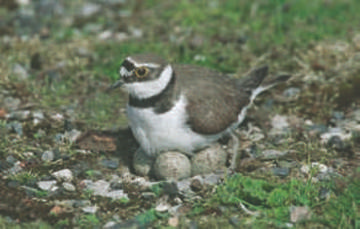Little Ringed Plover (Charadrius dubius)

Little Ringed Plover © David Platt
In Britain, Little Ringed Plovers are birds of unvegetated industrial and post-industrial land. This is a transient habitat and breeding sites are seldom occupied for more than a few years. The large sand quarries may provide newly exposed areas year after year, but other sites tend to become too overgrown and thus unsuitable for this species. It is no surprise that there is a high proportion of ‘red’ dots on the ‘change’ map: they were recorded in 57 tetrads in our First Atlas, and 47 in this survey, but only 21 of the tetrads had birds present in both atlases. Many of the gains and losses appear to be randomly scattered, although they have colonised north Wirral and it is noticeable that several non-industrial sites are now being used amongst agricultural land, and there are far fewer records now than twenty years ago in the Mersey Valley, the species’ former stronghold.
For a bird that likes such artificial sites it can be tricky to decide on the appropriate habitat codes, and observers submitted a wide variety: 59 records comprising 17 different codes. The majority were category G (freshwater), with 13 G5 (sand-pits), 8 G3 (lakes or reservoirs) and 7 G2 (small waterbodies). Few fieldworkers were licensed to approach the breeding area of this Schedule 1 species, but adults or chicks can often be seen from afar without illegal disturbance. Reported nesting areas included several industrial sites with restricted access, some of them hazardous or toxic to humans. As well as sand, nests appeared to be on concrete, rubble, flyash, lime and crushed limestone. Other sites with successful breeding included a new golf course development, and some on agricultural land, nesting in a ‘rubbish strewn area of ploughed field’ and on bare ground in crops, of miscanthus and sparsely germinated rape with much bare ground. This opportunistic species will use completely dry areas but several observers noted that temporary flooding by heavy rainfall encouraged a pair to nest, but breeding often failed following the transient pool drying up.
The nest is completely exposed on flat ground, the birds relying for concealment on their camouflage and that of their eggs. At 22 nests that I have found in which the eggs were incubated to hatching, at various Cheshire sites in the years 1982 to 2004, hatching dates ranged from 24 May to 23 July. There can be high losses to predation from foxes and corvids, and Little Ringed Plovers may re-lay two or three times, but true second broods are unusual. As with many species with nidifugous young, production of the eggs requires a tremendous reproductive effort, the normal clutch of four eggs weighing as much as 70% of the female’s own weight. The benefit is that the chicks grow well during their 24 days in the egg, with sharp eyesight and their legs almost fully developed from the moment that they hatch. At a few hours of age, chicks run around feeding themselves – picking insects from the surface of damp ground – attended by their parents whose alarm call makes them crouch flat or run into the edge of cover. In twelve tetrads surveyors reported seeing chicks, and at several sites observers reported the ‘broken-wing’ display of an adult trying to lure them away from their nest or young, this being one of the classic species employing such a distraction display.
Our First Atlas reported that competition with Ringed Plovers had been a problem for this species, its larger cousin often being on territory in March, before Little Ringed Plovers returned from their west African wintering areas. Such antagonism appears to have become less of an issue since the mid 1980s, perhaps because only 12 tetrads had records of both species during this Atlas. Little Ringed Plover is believed to be one of the species for which all birds found in the breeding season are probably recorded in the annual county bird reports. From 1985 to 2006 the breeding totals have fluctuated in the range 14 to 32 pairs. Bearing in mind that this Atlas map aggregates three seasons’ records, and that few observers found more than one pair in a tetrad, the present population is probably around 20 pairs. The last BTO-organised national survey, in 1984, found 21-24 pairs in Cheshire and Wirral, and the results of the 2007 BTO survey will make an interesting comparison. Baker et al. (2006) estimated the UK population to be 825-1,070 pairs.
Sponsored by South-East Cheshire Ornithological Society

